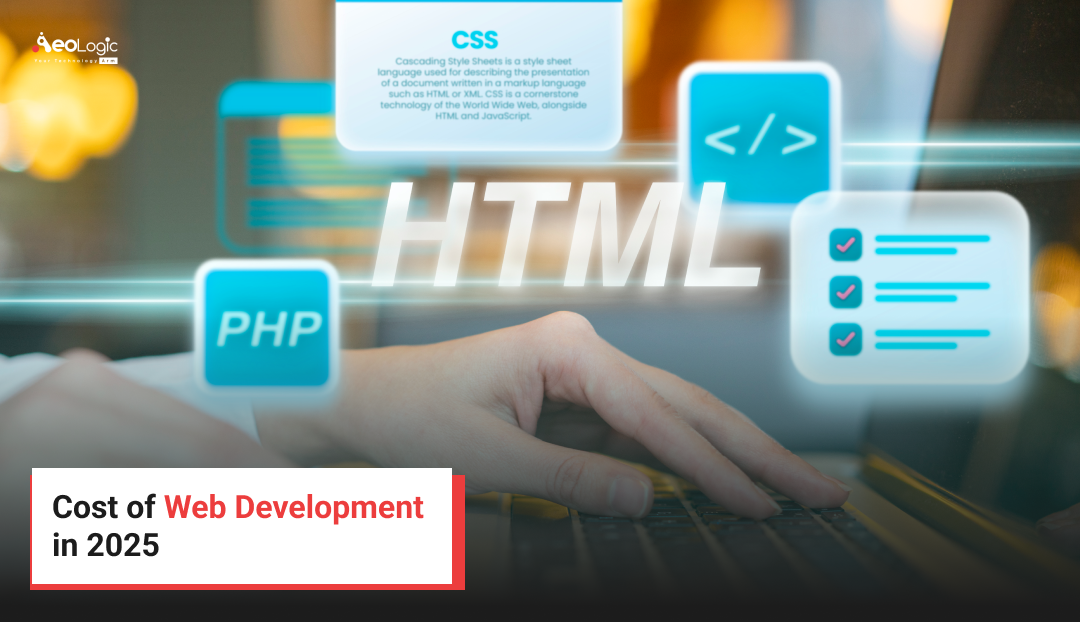A website is no longer just a digital presence — it’s the foundation of every modern business. Whether it’s an e-commerce store, corporate website, or custom web application, an online platform determines how customers perceive and connect with a brand. As technology continues to evolve, the demand for advanced, fast, and interactive websites has increased. Businesses are now investing in innovative designs, seamless user experiences, and powerful backend systems to stand out. This blog explores every element that defines the Cost of Web Development in 2025 and offers detailed insights to help businesses plan their budgets efficiently.
However, one major question remains constant — what is the actual Cost of Web Development in 2025? The answer depends on various factors, including design complexity, technology stack, features, and location of the development team. With the rapid adoption of AI, automation, and cloud platforms, web development is changing — and so are the costs associated with it.
Overview of the Web Development Market in 2025
The web development market continues to expand as digital transformation becomes a top priority across industries. According to recent research, the global web development market is projected to reach USD 96 billion by 2030, growing at a CAGR of around 8.7% from 2025 to 2030.
More than 65% of businesses plan to redesign or upgrade their websites by 2025, driven by emerging technologies such as AI chatbots, voice search optimization, and real-time analytics. E-commerce platforms, SaaS businesses, and startups are at the forefront of this transformation.
The increasing shift towards cloud-based applications and mobile-responsive websites has also influenced pricing. In 2025, websites are not just about aesthetics — they are built for performance, scalability, and data security.
Factors Affecting the Cost of Web Development
Before beginning a web project, it is important to understand the main factors that affect the Cost of Web Development in 2025. Each element — from design to hosting — plays a crucial role in shaping the total budget.
1. Type of Website
The purpose of the website directly influences its cost. A simple portfolio site will cost far less than a large e-commerce or enterprise web application.
2. Design and User Experience
An appealing and user-friendly design requires professional UI/UX experts. Custom designs with animations, transitions, and brand-specific visuals demand more time and expertise, increasing the cost.
3. Development Platform and Technology Stack
The choice of programming languages, frameworks, and CMS platforms (like WordPress, React, or Django) also impacts the budget. Using advanced technologies and custom integrations requires more development effort.
4. Functionality and Features
Features such as user registration, shopping carts, chatbots, booking systems, or payment gateways add complexity. The more functionalities you add, the higher the Cost of Web Development.
5. Responsiveness and Mobile Compatibility
In 2025, mobile-first design is a necessity. Building responsive layouts that perform equally well on smartphones, tablets, and desktops adds to development time.
6. Development Team’s Location
The region where your development team is located heavily affects pricing. Developers in North America charge more compared to Asia or Eastern Europe.
7. Maintenance and Updates
Regular updates, content management, and technical support add recurring costs. Maintenance generally accounts for 15–20% of the initial development cost per year.
Cost Breakdown Based on Website Type
Different kinds of websites have different requirements, which influence the overall Cost of Web Development. Below is a breakdown of estimated costs based on the type of website in 2025.
1. Basic Informational Website
A simple website with basic pages like Home, About, Services, and Contact. Suitable for small businesses or personal brands.
Estimated Cost: USD 2,000 – 10,000
2. Corporate Website
Corporate websites include interactive sections, CMS integration, and better design with security features.
Estimated Cost: USD 10,000 – 30,000
3. E-Commerce Website
E-commerce sites require product pages, payment gateways, inventory systems, and data analytics. These demand complex architecture and third-party integrations.
Estimated Cost: USD 30,000 – 150,000
4. Custom Web Application
These are highly tailored solutions with automation, dashboards, and data analytics — for industries like logistics or finance.
Estimated Cost: USD 40,000 – 250,000
5. SaaS Platform
Developing Software-as-a-Service (SaaS) applications involves cloud integration, multi-user support, and subscription management.
Estimated Cost: USD 60,000 – 300,000+
6. Portfolio or Personal Website
Simple creative websites for individuals or freelancers. Usually require minimal backend and design effort.
Estimated Cost: USD 1,000 – 5,000
Regional Cost Differences for Web Development
Web-development costs vary across regions because of differences in labor rates, infrastructure, and technical specialization. Below are the estimated price ranges for 2025 based on global averages.
1. North America (USA and Canada)
North America remains the most expensive region for web development. Agencies here offer high-quality coding standards, robust security compliance, and UI/UX excellence.
Estimated Cost: USD 100 – 180 per hour
Average Project Range: USD 30,000 – 250,000 or more
2. Western Europe (UK, Germany, France)
European companies maintain a strong balance between creativity and technical precision. Projects often include multilingual support and GDPR compliance.
Estimated Cost: USD 70 – 150 per hour
Average Project Range: USD 25,000 – 200,000
3. Eastern Europe (Poland, Ukraine, Romania)
Eastern Europe is a popular destination for outsourcing because it offers skilled developers at moderate rates and strong communication standards.
Estimated Cost: USD 40 – 80 per hour
Average Project Range: USD 15,000 – 100,000
4. Asia (India, Vietnam, Philippines)
Asia offers the most competitive pricing without sacrificing technical quality. India in particular leads in large-scale custom development and enterprise solutions.
Estimated Cost: USD 20 – 50 per hour
Average Project Range: USD 5,000 – 60,000
5. Australia and New Zealand
Australia combines high development costs with excellent project management and fast delivery. It is best suited for enterprise-level projects needing local regulatory compliance.
Estimated Cost: USD 70 – 130 per hour
Average Project Range: USD 20,000 – 150,000
Additional Expenses in Web Development
Apart from design and coding, several hidden or ongoing costs affect the final budget for a website in 2025. These costs are essential for long-term stability and performance.
1. Domain Registration
Domains usually cost between USD 10 and 50 per year, depending on the extension and provider. Premium domains can cost thousands.
2. Web Hosting
Shared hosting is cheaper but limited in resources. Dedicated and cloud servers like AWS and Azure offer better performance at higher rates.
Estimated Annual Cost: USD 300 – 5,000
3. SSL Certificates and Security
Security is non-negotiable. SSL certificates, firewall services, and malware protection increase trust and compliance.
Estimated Annual Cost: USD 100 – 1,000
4. Third-Party Integrations
Websites often integrate APIs for payments, analytics, or marketing tools. Each integration can add licensing and setup fees.
5. Content Creation and SEO
Professional copywriting, graphics, and SEO optimization improve visibility but add extra spending.
Estimated Cost: USD 1,000 – 10,000
6. Maintenance and Support
Monthly maintenance includes updates, backups, and technical support. This is typically 15 to 25 percent of the initial build cost per year.
Ways to Reduce Web Development Cost
Even with rising demand for advanced features, businesses can adopt strategies to manage and reduce the overall Cost of Web Development in 2025.
1. Use Open-Source Platforms
Content management systems like WordPress and Joomla lower coding costs and provide ready-made plugins for faster development.
2. Adopt Template-Based Designs
Templates and pre-built themes cut design time and are ideal for small business websites that don’t require custom features.
3. Outsource to Cost-Effective Regions
Hiring agencies or freelancers from Asia or Eastern Europe can reduce expenses by up to 60 percent while maintaining quality.
4. Develop in Phases
Launching an MVP or basic version first allows you to test market response before adding advanced features.
5. Leverage Automation and AI
AI-based testing, code generation, and content tools help speed up development and lower labor costs without sacrificing accuracy.
6. Choose Cloud Hosting
Cloud services offer scalability so you pay only for resources used, reducing maintenance and infrastructure spending.
Future Trends Affecting Web Development Cost
The future of web development is shaped by new technologies that enhance performance and security but also influence pricing. Here are key trends for 2025 and beyond.
1. AI-Driven Web Development
Artificial intelligence is transforming how websites are built and managed. AI tools assist in coding, design, and content optimization. However, integrating AI chatbots or personalized recommendation engines adds to the overall Cost of Web Development.
2. Progressive Web Apps (PWAs)
PWAs combine the best of web and mobile apps for faster performance and offline capabilities. Developing PWAs is slightly costlier than traditional websites but reduces maintenance in the long term.
3. Voice Search and Accessibility
Websites optimized for voice search and accessibility require advanced frameworks and testing. This trend is growing as users demand hands-free and inclusive experiences.
4. Cybersecurity Enhancements
With increasing cyber threats, businesses are investing in AI-based security, multi-factor authentication, and data encryption — adding slight cost increases but ensuring trust.
5. Cloud-Native and Serverless Architecture
Serverless computing reduces infrastructure management but involves higher initial setup costs. It offers long-term scalability and lower downtime.
6. Sustainability and Green Hosting
Eco-friendly web solutions are becoming important. Green hosting and optimized code reduce energy consumption but may increase setup expenses slightly.
7. Augmented Reality and 3D Elements
AR and 3D visuals enhance user engagement on e-commerce and real-estate websites. These features require specialized skills, impacting overall development costs.
Conclusion
The Cost of Web Development in 2025 depends on many factors — from project complexity and team location to chosen technologies and ongoing maintenance. While advanced technologies like AI, PWA, and blockchain can increase costs, they also create faster, more secure, and scalable digital experiences.
Businesses should plan budgets strategically, starting with clear goals and gradual development phases. Investing in a well-structured and efficient website is no longer a luxury — it’s a necessity for staying competitive in the digital world.
Those who understand and optimize the Cost of Web Development will achieve not just an online presence but a strong, future-ready digital foundation that drives growth and innovation.
FAQs
1. What is the average Cost of Web Development in 2025?
The average cost ranges from USD 5,000 to 150,000, depending on complexity, features, and region.
2. Which factors impact web development cost the most?
Website type, design complexity, technology stack, and developer location are the main cost drivers.
3. Is it cheaper to use a website builder than hire a developer?
Yes, but website builders limit customization and scalability. Professional development offers better long-term returns.
4. How can I reduce web development cost without compromising quality?
Use open-source tools, outsource development, and launch in phases to manage spending effectively.
5. What future trends will affect web development costs?
AI, PWA, cloud-native development, and enhanced cybersecurity will influence future pricing models.

Passionate about breaking down complex tech into simple ideas. Covers everything from AI and software development to gadgets and emerging tech trends.






